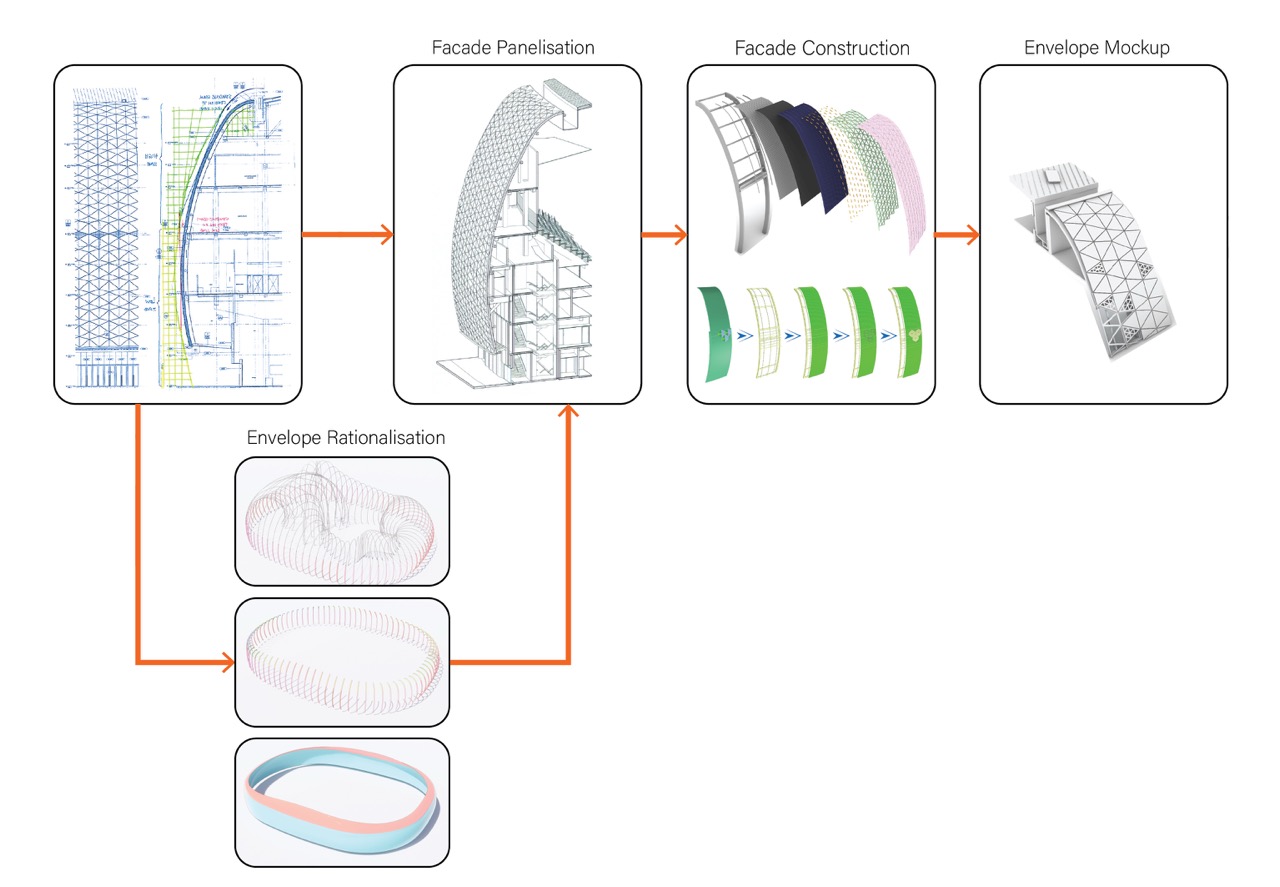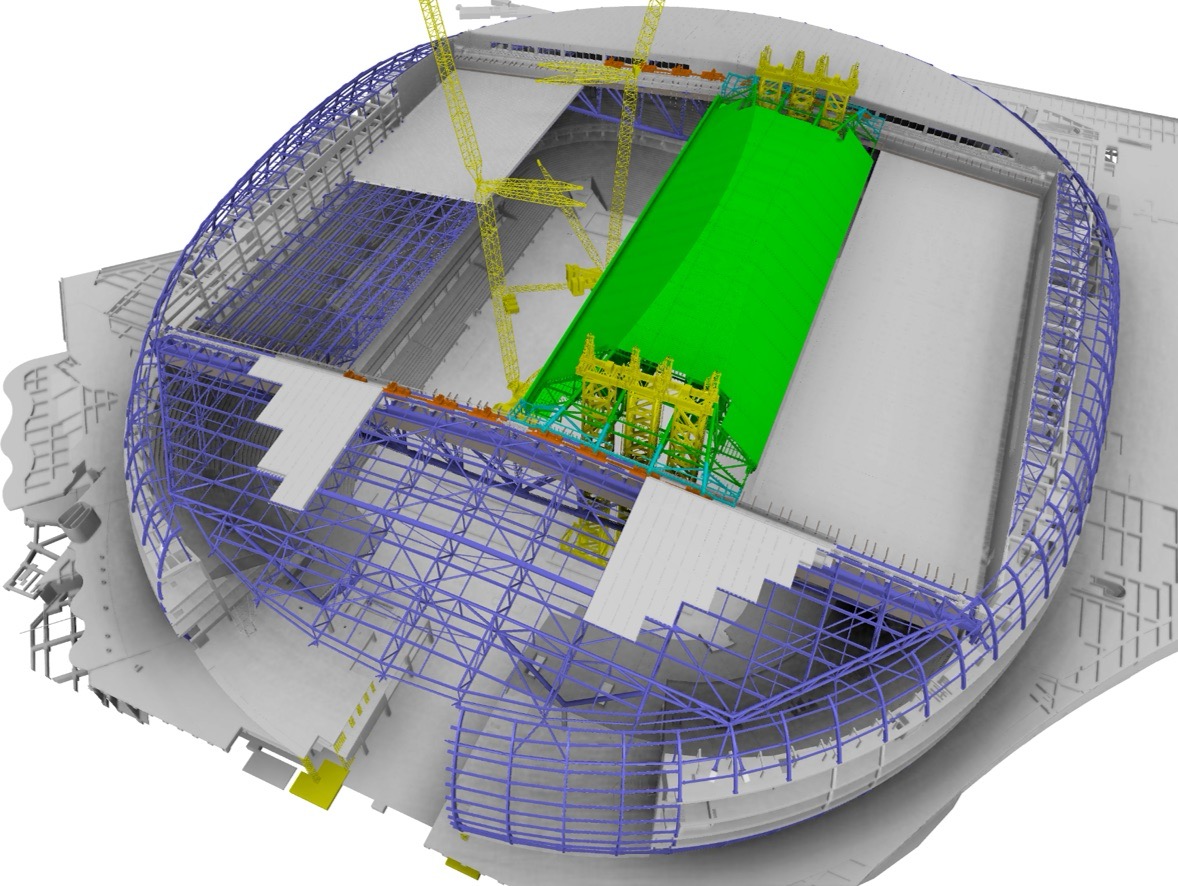

How do digital technologies contribute to the design, construction and operation throughout the project lifecycle?
「將概念轉化為現實的過程中,我們必須應對各種營運需求和施工上的挑戰。這是一個漫長而複雜的過程,需要整個項目團隊的密切合作與協調,以及科技的輔助,才能確保每個階段的順利推進和成功實現。」
Kai Tak Sports Park [KTSP] is a 28-hectare urban oasis set against the backdrop of Hong Kong’s iconic Lion Rock. It serves as the centrepiece development within the overall Kai Tak New Development Area, which has revitalised the land formerly occupied by the Kai Tak Airport and will be a global centre for major international events as well as daily local community activities.
A Sports Park for All
The integrated site design for KTSP helps to bring all elements together by linking the community, parklands and harbour, enhancing overall greening and building design. The design team break down the public realm into discrete entertainment, engagement and relaxation points, providing a people-centric solution for visitor circulation in a large area. During major events, the precinct efficiently facilitates spectator movement throughout and into the adjacent neighbourhoods. On non-event days, the key nodal points and areas transform into vibrant spaces for hosting mini-events or simply for community enjoyment [01,02]. Four key themes are central to the master planning:
The design team considers the operational implications of a multi-venue precinct, particularly the segregation between front-of-house functions and vehicle movements. They are separated by a podium above, the “Central Square” [03], from the back-of-house functions below. Having operational functions underneath helps with noise and light spill, which is important given its proximity to dense neighbourhoods and provides protection from the elements.



Key Design Features
Conceived as ‘a Pearl within the park’, the 50,000-seat Kai Tak Stadium features a subtly iridescent exterior reminiscent of the “Pearl of the Orient”. [04] Its panels create a shimmering pearlescent effect, shifting colour from cobalt blue to metallic purple and silver throughout the day. Viewed from the Victoria Harbour, it adds an instantly recognisable new landmark to Hong Kong’s skyline. [05]
The Kai Tak Stadium has a retractable roof with effective sound insulation for all weather conditions and a flexible pitch surface that accommodates both natural and artificial turf or hard surfaces for various events [06, 07]. With the dedicated Stage Pocket design for staging and customisable seating configurations, the stadium is capable of hosting entertainment and community events [08]. Strategically locating the running track at Kai Tak Youth Sports Ground, the Kai Tak Stadium brings spectators closer to the pitch, which enhances the overall fan experience. The Kai Tak Arena is a large multipurpose space featuring 10,000 retractable or removable seats and a trafficable walking grid for rigging, making it suitable for hosting a diverse range of sporting and entertainment events and providing indoor sports courts for community use [09]. Finally, the 5,000-seat Kai Tak Youth Sports Ground is designed to host school athletics meetings and training, rugby and local football league games, which will be open to the public for jogging and exercise [10].







Challenges and Complexity
Collaboration amongst project stakeholders was one of the major challenges of this large-scale project. The project was delivered by more than 140 companies and over 3,000 professionals worldwide across six time zones.
Despite disruptions caused by the COVID-19 pandemic, a cloud-based design coordination platform enabled sharing of the work, reinforcing collaboration and leveraging data management among teams beyond physical locations and time zones. The team also developed a wide range of automation tools for design development and statutory checking, which enhanced drawing production and coordination efficiency. The COVID-19 pandemic also significantly impacted the original construction process, affecting various steps and workflow. In response, the construction team made appropriate adjustments to mitigate the implications on Kai Tak Stadium, such as the adoption of a bespoke portal gantry for the installation of precast seating to overcome the limited working space and increasing capacity of the heavy lifting of the mega steel trusses, which enabled us to achieve a more effective and safe steel works erection. These changes helped to maintain the continuity in construction despite the challenging circumstances.
Technical Innovation
Embracing BIM throughout the project lifecycle: A key factor in the development and delivery was the use of Building Information Modelling (BIM) featuring Virtual Design Construction. This digital twin technology provided an opportunity to test the operational performance of the design and to identify and resolve clashes within a live environment, enhancing construction efficiency [11]. The Kai Tak Sports Park project team won the buildingSMART International openBIM Award 2024 in the category of Design for Buildings from 164 global submissions, and the project was also chosen as one of the two finalists in the category of Construction for Buildings. This honour highlights the project team’s architectural design and technology application excellence. It proves an undoubted pride for Hong Kong that its projects can truly stand out at the forefront of the world.



Sightline optimisation: BIM tools were utilised to validate and optimise the seating bowl design continuously to maximise sight lines and minimise obstructions for spectators throughout the stadium [12]. The vertical supports of the mega trusses are carefully located behind the seating bowl, achieving a column-free design to ensure every spectator has an unobstructed viewing experience [13].
%20Large.jpeg)

Stadium Façade Profile Modelling and Rationalisation: The Kai Tak Stadium façade demonstrates simplicity in design but involves a complex process in turning it into reality. The initial concept required over 47,000 panels of varying shapes and sizes. However, through parametric design techniques, the team efficiently rationalised this to just 27,000 panels with only two main geometry types, significantly reducing installation time. The entire process, from design to construction, was executed digitally. By implementing an openBIM approach, the design model was seamlessly transferred to the fabrication model for digital construction. By adopting façade panels design optimization and Design for Manufacture and Assembly (DfMA) digital workflow, the panelisation and assembly uncertainty have been reduced, minimising material consumption, production time and fabrication cost [14].


Stadium Steel Roof Optimisation: A digital workflow was established for geometric modelling, structural design analysis and optimisation to improve design efficiency, coordination and fabrication. The heavy lifting of mega steel trusses and retractable roof by the strand jacking system allowed for very little tolerance. Therefore, the construction team extensively modelled the entire Construction Method and Erection Sequence (CMES) and carefully examined deviation analysis using laser scanning, ensuring the precision as required in construction [15].
OpenBIM adoption to sustainability-related analysis: Detailed sustainability-related analysis using the openBIM platform is adopted, including glare analysis simulation, acoustic modelling simulation, and solar study, in order to achieve the sustainable goal with BEAM Plus Platinum, LEED Gold Certification and China 3 Star Green Certification.
Crowd dispersal simulation – utilize BIM model with MassMotion: Crowd simulation leverages the openBIM format file that helps predict and optimise mass movements during events. The simulation utilises the data-rich BIM model with MassMotion, which enables data reuse and thus enhances the efficiency and accuracy of the study. To secure the safety and efficiency of spectators when dispersing from the 50,000-seat Kai Tak Stadium, it was adopted in the early design stage to ensure there was no bottleneck that could cause a significant hazard while the dispersal time was within the performance criteria [16].


Conclusion
Technology empowers the KTSP to meet its commitment to sustainable development by enhancing design, construction, project management, and asset management. By increasing overall productivity in the construction industry, this project aims to set a benchmark for future urban developments, aligning with government standards and contributing to the vision of a sustainable and vibrant community. The evolution of Kai Tak Sports Park from concept to reality showcases the successful integration of innovative design, operational efficiency, digital technology and sustainable practices, making it not only a landmark development for Hong Kong but also a remarkable example of world-class sports, entertainment, and leisure facilities for the enjoyment of Hong Kong, Asia, and beyond.
Kai Tak Sports Park
Sports, Entertainment and Leisure Facilities
Complete 2025
Kai Tak, Kowloon (former Kai Tak Airport)
28 Hectare
Culture, Sports and Tourism Bureau
Kai Tak Sports Park Limited
Hip Hing Engineering Co. Ltd.
Populous Limited
Simon Kwan & Associates Limited
Ove Arup & Partners Hong Kong Limited
Ove Arup & Partners Hong Kong Limited
ADI Limited
Ove Arup & Partners Hong Kong Limited